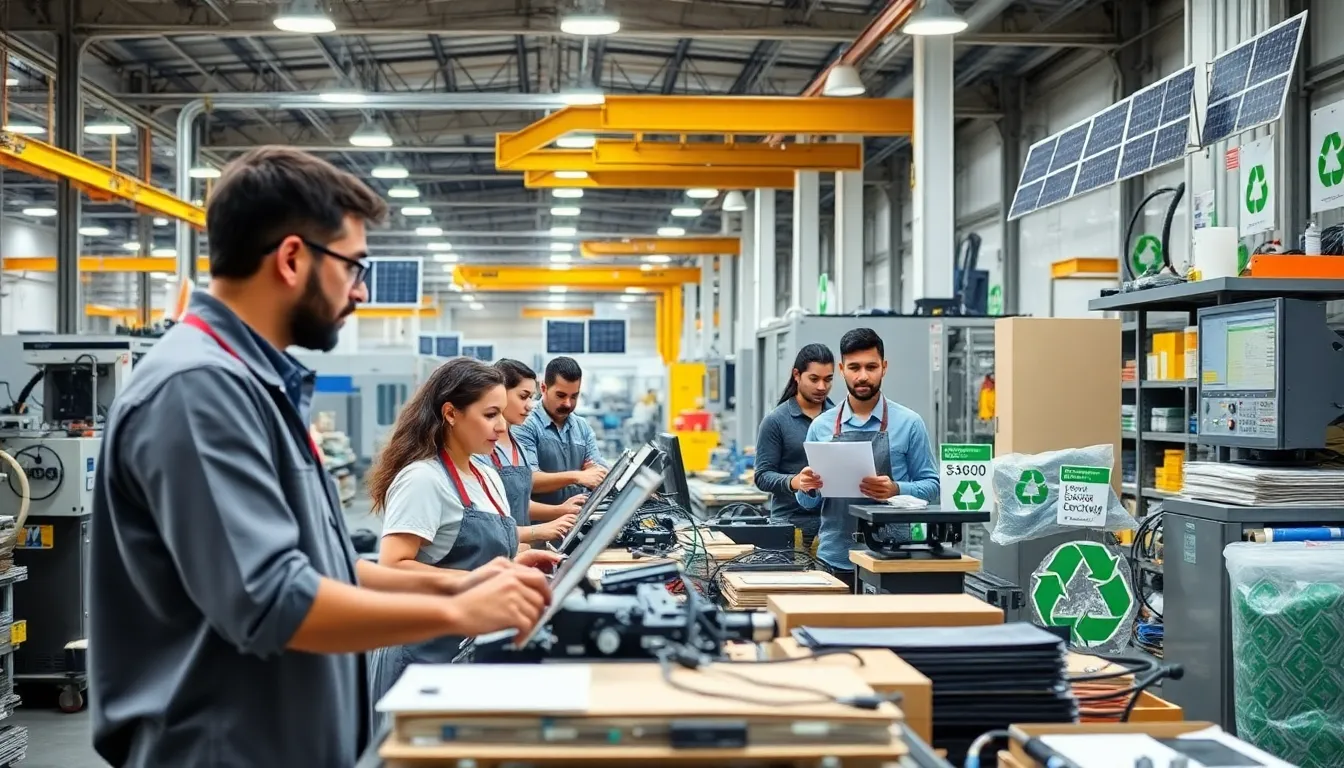In a world where the planet seems to be throwing a tantrum, sustainable manufacturing technology steps in like a superhero with a cape made of recycled materials. It’s not just about saving the Earth; it’s about making production processes smarter, cleaner, and downright cooler. Imagine factories that run on renewable energy and produce less waste than a toddler’s snack time.
This isn’t just a pipe dream; it’s happening right now. Companies are swapping out old-school methods for innovative solutions that not only save the planet but also boost their bottom line. So, buckle up as we dive into the exciting world of sustainable manufacturing technology, where eco-friendliness meets efficiency, and everyone gets to feel good about their choices (yes, even your skeptical uncle).
Table of Contents
ToggleOverview of Sustainable Manufacturing Technology
Sustainable manufacturing technology encompasses methods that minimize environmental impact while maximizing efficiency. This approach integrates renewable energy, efficient resource usage, and waste reduction into production processes. Businesses increasingly invest in these technologies, recognizing their role in reducing operational costs and improving market competitiveness.
Renewable energy sources like solar, wind, and biomass feature prominently in sustainable manufacturing. By switching to these sources, companies lower greenhouse gas emissions significantly. In addition to renewable energy, smart technologies play a crucial role. Automation and data analytics enhance decision-making, enabling manufacturers to optimize their operations.
Efficient resource utilization drives the success of sustainable practices. Companies focus on reducing material consumption and recycling waste products. This circular economy model allows for the recovery and reuse of materials, minimizing waste and promoting a more sustainable production cycle.
Several industries, including textiles, automotive, and electronics, are leading the way in adopting sustainable manufacturing technologies. For instance, the automotive sector is exploring electric vehicles and sustainable materials to reduce its carbon footprint. The textile industry is also shifting toward organic fibers and eco-friendly dyes, catering to environmentally-conscious consumers.
Regulatory pressures and market demand further accelerate the adoption of these technologies. Governments worldwide implement stricter guidelines to reduce industrial pollution. Consumers increasingly seek products that align with their values, pushing companies to adopt sustainable practices.
Innovation drives the evolution of sustainable manufacturing technology. Businesses that embrace these advancements position themselves as industry leaders, enhancing their brand image. Overall, adopting sustainable manufacturing technology proves beneficial for the environment and a profitable strategy for businesses.
Key Principles of Sustainable Manufacturing

Sustainable manufacturing relies on various principles designed to benefit both the environment and business practices. Resource efficiency and waste reduction serve as foundational elements in this approach.
Resource Efficiency
Resource efficiency emphasizes maximizing the use of materials while minimizing consumption. Companies are encouraged to focus on optimizing manufacturing processes to reduce raw material use and energy consumption. Implementing advanced technologies, such as IoT and data analytics, enables manufacturers to monitor resource utilization in real time. For instance, utilizing renewable energy sources, such as solar and wind, leads to lower operational costs and carbon footprints. Adaptive machinery further enhances efficiency, allowing for flexible production that aligns with market demand while conserving resources.
Waste Reduction
Waste reduction strategies play a crucial role in sustainable manufacturing. Minimizing waste not only conserves resources but also cuts disposal costs. Companies can integrate recycling practices and upcycling methods to convert byproducts into usable materials. Adopting lean manufacturing principles fosters a culture of continuous improvement, leading to less waste generation overall. For example, innovative methods, like closed-loop systems, facilitate the reuse of materials within the manufacturing process. Emphasizing the reduction of packaging waste also contributes to an eco-friendlier production cycle.
Innovations in Sustainable Manufacturing
Innovations in sustainable manufacturing revolutionize production methods, promoting eco-friendly practices. This transformation centers around integrating renewable energy and advanced materials.
Renewable Energy Integration
Utilizing renewable energy reduces reliance on fossil fuels in various manufacturing sectors. Solar panels generate power on-site, lowering production costs while enhancing sustainability. Wind turbines harness energy, delivering a consistent energy supply to factories. Biomass energy systems convert organic materials into usable power, providing additional renewable options. Companies implementing these sources often see significant reductions in greenhouse gas emissions and operational costs. Data indicates that businesses using renewable energy sources can lower emissions by 30% or more, showcasing the environmental benefits of this approach. Each step toward renewable energy integration plays a crucial role in sustainable manufacturing.
Advanced Materials
Advanced materials contribute significantly to sustainable manufacturing processes. Lightweight composites, for example, enhance efficiency in automotive and aerospace industries, reducing fuel consumption. Biodegradable plastics serve as alternatives to conventional materials, minimizing environmental impact. Innovations in nanomaterials improve product lifespan while reducing waste generation. Furthermore, recycled materials become increasingly prevalent, allowing companies to lower material costs and enhance sustainability. Manufacturers adopting advanced materials often report enhanced performance alongside cost savings. Studies reveal that utilizing advanced materials can reduce resource consumption by up to 50%, supporting the overarching goal of sustainable production.
Challenges in Sustainable Manufacturing Adoption
Sustainable manufacturing faces several challenges that hinder its widespread adoption. Economic considerations significantly impact companies looking to implement these technologies.
Economic Considerations
Initial costs frequently deter investment in sustainable manufacturing methods. Companies often grapple with the expense of transitioning from traditional processes to eco-friendly alternatives. Long-term savings can be substantial, but many firms struggle to justify upfront costs. Additionally, the return on investment may not be immediate, causing hesitation among stakeholders. Companies in emerging markets experience further complications due to limited access to financing options. Despite these drawbacks, integrating sustainable practices can lead to improved efficiency and lower operational costs.
Policy and Regulation Barriers
Policy and regulation barriers also limit the adoption of sustainable manufacturing. Ambiguity in governmental guidelines makes compliance challenging for businesses. Uncertainty regarding regulations can lead to inaction or non-compliance, trapping companies in outdated practices. Inconsistent enforcement across regions adds complexity, as businesses navigate varying local and national laws. Removing these barriers could encourage more organizations to invest in sustainable technologies. Streamlining regulations may foster a supportive environment for innovation and motivate firms to prioritize sustainable methods.
Future Trends in Sustainable Manufacturing Technology
Emerging technologies play a crucial role in shaping the future of sustainable manufacturing. Adoption of artificial intelligence and machine learning enhances predictive maintenance, allowing companies to optimize resource allocation. These technologies reduce downtime and increase efficiency, driving significant cost savings.
Industry 4.0 promotes interconnectivity among machines and systems, enabling real-time data sharing for improved decision-making. Companies leveraging the Internet of Things (IoT) achieve greater visibility across operations, facilitating resource tracking and minimizing waste. This interconnected approach fosters a more responsive and agile manufacturing environment.
Integration of circular economy principles transforms traditional manufacturing models. Focus on product life cycle extends beyond initial production, encouraging businesses to design for recyclability and reuse. Such designs support waste reduction by repurposing materials and minimizing landfill contributions.
Investment in advanced manufacturing processes, such as additive manufacturing, offers further potential for sustainability. This technique reduces material waste by building components layer by layer, creating precise products that meet specifications. Studies indicate that 3D printing can cut material usage by up to 60% compared to conventional processes.
Collaboration among stakeholders accelerates innovations in sustainable practices. Partnerships between manufacturers, suppliers, and consumers foster knowledge sharing and drive the development of green technologies. Collaborative efforts help establish industry standards that promote sustainability across sectors.
Regulatory environments are evolving to support sustainable initiatives. Governments increasingly implement incentives for businesses to adopt eco-friendly practices, pushing industries toward greener solutions. Such policies not only encourage compliance but also stimulate market demand for sustainably manufactured products.
These trends signal a robust transition toward an environmentally responsible manufacturing landscape. Continuous innovation ensures companies maintain competitiveness while addressing pressing environmental challenges.
Sustainable manufacturing technology is reshaping industries by aligning environmental responsibility with operational efficiency. As businesses embrace these innovative practices, they not only contribute to a healthier planet but also enhance their competitive edge. The integration of renewable energy and advanced materials is paving the way for smarter production processes that minimize waste and resource consumption.
The ongoing evolution of this field highlights the importance of collaboration and adaptability. Companies that invest in sustainable technologies are positioning themselves for long-term success. By overcoming barriers and embracing innovation, they can lead the charge toward a more sustainable future. The transition to sustainable manufacturing isn’t just beneficial; it’s essential for fostering a resilient economy and a thriving environment.






